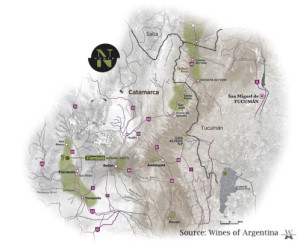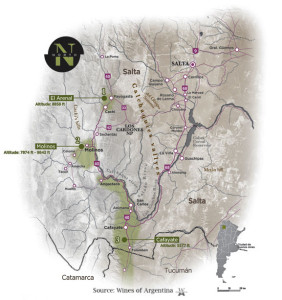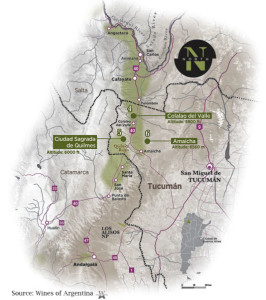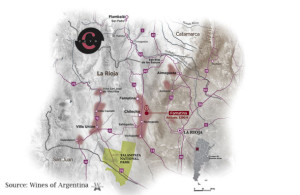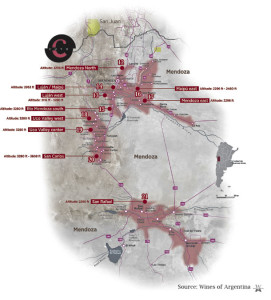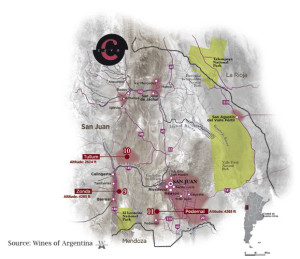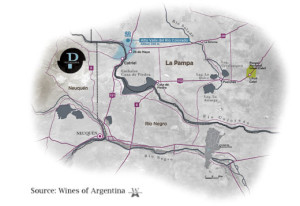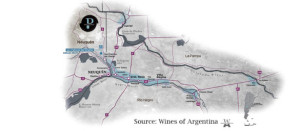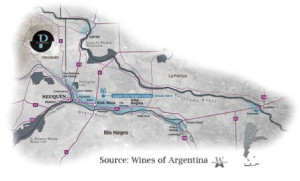Argentina and wine goes back to the 16th century. However, it was in the mid 19th century the Italian and European immigrants laid the foundation for the current wine industry in Argentina. In the 20th century, the wine industry was being modernized. It was in the 1990’s that new technology and new wine making techniques were being utilized.
Argentina is the 8th world’s largest producer and exporter and is the 11th world largest consumer of wine. You hear Argentina and wine, you then think about their world known grapes of Malbec and Torrontes and the wines they produce from these grapes.
Less heard of but very popular in Argentina is the traditional grape variety of Bonarda. It is the second most planted red variety in Argentina.
Grapes of Argentina
The grapes that represent the history of Argentina and the present Argentina are Malbec, Bonarda and Torrontes. However, Argentina also produces the following international red grape varietals: Cabernet Sauvignon, Syrah, Merlot, Tempranillo, Sangiovese, and Pinot Noir in this order of production. For the white grape varietals Argentina also produces: Pedro Gimenez , Chardonnay, Chennin, Sauvignon Blanc, Semillon and Viognier in this order of production.
Malbec- Malbec has found its new home in Argentina. The grape variety is originally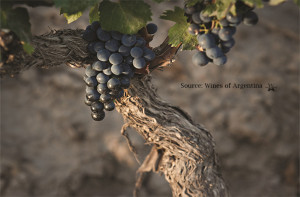 from Cahors in Southwest France and is known as the Cot grape variety in France. This is the most widely planted red or white grape varietal in Argentina with Mendoza being the province with the largest planted vineyards.
from Cahors in Southwest France and is known as the Cot grape variety in France. This is the most widely planted red or white grape varietal in Argentina with Mendoza being the province with the largest planted vineyards.
The varietal profile is that it is deeply colored with fresh concentrated black fruits, minty spice and some earthiness but soft and round in the mouth. It is juicy and smooth with a reasonable high alcohol level.
Bonarda– It is the second most grown grape in Argentina with most of it being grown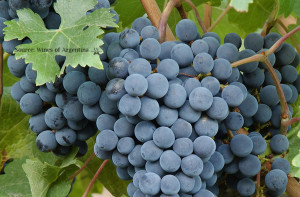 in Mendoza. In 2012 it represented 17% of the red grape varieties planted. For Argentina, this grape is just as traditional as Malbec. Being a vigorous and high yielding grape, it makes an economical bottle of wine.
in Mendoza. In 2012 it represented 17% of the red grape varieties planted. For Argentina, this grape is just as traditional as Malbec. Being a vigorous and high yielding grape, it makes an economical bottle of wine.
Bonarda is mostly used as a blending grape but it can be found as a single varietal bottling. When used as part of a blend the Bonarda grape adds aromatics and color. This grape variety is also known as Douce Noir and in California it is known as Charbono.
The varietal profile is aromatic with bright cherry, raspberry and plum while being structured with balanced tannins. Violets are known to flow from the glass.
Torrontes– It is the second most grown white grape in Argentina with about 20,000 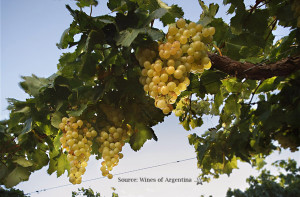 acres planted. The grape Pedro Giminez is the most grown with about 30,000 acres planted. In 2012 it represented 18% of the white grape varieties planted. It is grown throughout Argentina however the Cafayette Valley in the Salta Provence produces the most representative of what this varietal is all about.
acres planted. The grape Pedro Giminez is the most grown with about 30,000 acres planted. In 2012 it represented 18% of the white grape varieties planted. It is grown throughout Argentina however the Cafayette Valley in the Salta Provence produces the most representative of what this varietal is all about.
The varietal profile is tropical/exotic aromas of honeysuckle, jasmine white peaches grapefruit with floweriness in the mouth and a crisp finish with its moderate to high acidity levels.
Grape Growing Regions of Argentina
The grape growing regions in Argentina stretch from latitude 22 degrees south to 42 degrees south. Due to a lack of a body of water nearby and cold winters, warm summers and minimal rain in the summer, the climate of Argentina is considered to be Dry Continental.
south. Due to a lack of a body of water nearby and cold winters, warm summers and minimal rain in the summer, the climate of Argentina is considered to be Dry Continental.
Most of the vineyards are planted at high altitudes which makes this South American country able to grow quality grapes. These vineyards planted at the high altitudes have hot days and cool nights with a temperature difference that can range up to 50F degree between day and night. Vineyards planted on the plains or at low altitudes produce less of a quality grape but still produces a delicious wine on a mass production level. With such a large growing area there are many different soils that the vines are planted in. But all the soils have low fertility.
The vineyards are located in semi arid areas where the rainfall ranges from 6 to 16 inches annually. This dry climate promotes vineyard health by not inviting pests and creating fungus loving environments. Also, the vineyards are being irrigated with the pure waters from the melting snow of the Andes Mountains. With less need for pesticides, here it is easy for the winemakers to produce organic wines.
Starting from the North let us look at the wine making regions which cover about 504,000 acres.
Northern Region
This region has the highest vineyards in the world with a range of 3,200 to 9,800 feet above sea level with a dry warm climate. Up North, Torrontes is the most popular variety grown.
Vineyard Area: 1.14% of the total vineyard area of Argentina
Vineyard Altitude Range: 3,300 feet to 7,200 feet above sea level
Average Temperature: 65F
Average Annual Rainfall: 17 inches
Main Regions: Tinogasta, Santa Maria and Belén
Main Grape Varieties: Torrontes, Syrah, Malbec, and Cabernet Sauvignon.
Vineyard Area: 1.30% of the total vineyard area of Argentina
70% of the vineyards are concentrated in the region of Cafayette in the Calchaquies Valleys.
Vineyard Altitude Range: 4,200 to 9,860 feet above sea level
Average Temperature: 59F
Average Annual Rainfall: 8 inches
Main Regions: Cafayate
Main Grape Varieties: Torrontés, Malbec, Cabernet, Sauvignon and Tannat
This area shares the Calchaqui Valley which is one of the highest valleys in the world.
Vineyard Area: .04% of the total vineyard area of Argentina. Here they focus on the other agricultural products of sugarcane, lemons and strawberries
Vineyard Altitude Range: 5,577 to 8,202 feet above sea level
Average Temperature: 75F
Average Annual Rainfall: 11 inches
Main Regions: Colalao del Valle
Main Grape Varieties: Malbec, Cabernet Sauvignon, Syrah, Tanat, Bonarda and Torrontés
Cuyo Region
This translates in English to the Land of the Deserts. The Cuyo region is the largest wine producing area in Argentina with 482,385 (96%) acres of vineyards.
This region is characterized by rugged mountainous relief and its main source of irrigation is from the melt off from the Andes Mountains. The most widely grown grape variety here is the Malbec.
The vineyards of this area are located mainly in small irrigated valleys to the west of the province. Here there is more bulk grape growing than the traditional small farmer.
Vineyard Area:15.999 acres of vineyards
Vineyard Altitude Range: 5,640 feet above sea level
Average Temperature: 66F
Average Annual Rainfall: 5.11 inches
Main Regions: Nonogasta, Chilecito, Famatina and Antinaco
Main Grape Varieties: Torrontés, Bonarda, Malbec, Syrah & Cabernet Sauvignon
Mendoza is the main winemaking are of Argentina. More than 80% of Argentina wine is produced in Mendoza which includes 382,225 acres of vineyards.
Mendoza is broken up into five areas.
1) Mendoza Province – Northern Region
The northern region has the lowest altitude ranges of 1,900 and 2,300 feet above sea level with mild slopes. The soils are predominately fine sand. The region can grow such white wines such as Chardonnay, Sauvignon Blanc, Chenin, Ugni Blanc and Torrontés, and for reds like Syrah, Cabernet Sauvignon, Bonarda and Malbec.
2) Mendoza Province- East
The East of Mendoza has altitudes of 2,100 to 2,400 feet above sea level.
This sub region comprises the departments of Rivadavia, San Martín, La Paz and Santa Rosa.
All the grape varieties grown in Argentina are found in the East, but Chardonnay, Sauvignon Blanc, Chenin, Torrontés and Viognier stand out among the whites, and Sangiovese, Syrah, Bonarda and Tempranillo stand out among the reds.
3) Mendoza Province- Center
This region covers the departments of Luján de Cuyo and Maipú and is known as the “premium winemaking area. It is located south of the city and at altitudes of 2,130 to 3,500 feet above sea level.
The region most popular grape is Malbec. Other red varieties found here include Cabernet Sauvignon, Merlot, Pinot Noir and Syrah. Chardonnay and Sauvignon Blanc stand out among the whites.
4) Uco Valley
The Uco Valley comprises the Tupungato, Tunuyán and San Carlos departments. At 5,580 feet above sea level, this sub-region has the highest altitude vineyards in the province. This area produces red and white grapes with the greatest aging ability. The traditional varieties here are the Malbec, Merlot and Pinot Noir of La Consulta district. White varieties grown in the area include Chardonnay and Semillon.
5) Mendoza Province-South
It comprises the San Rafael and General Alvear departments.
The altitude of this region is from 1,480 to 2,600 feet above sea level.
It is the main producer of Chenin.
Other whites and reds are produced in this area, among which stand out Chardonnay, Malbec, Sauvignon Blanc, Merlot and Cabernet Sauvignon.
Vineyard Altitude Range: 1,500 to 5,580 feet above sea level
Average Temperature: 59/66F
Average Annual Rainfall: 7.9 inches
Main Regions: Northeastern, Central, Southern & Uco Valley
Main Grape Varieties: Malbec, Merlot, Cabernet Sauvignon, Torrontes, Chardonnay, Sauvignon Blanc & Viognier
San Juan is the second largest wine producing area in Argentina. Its valleys of Tulum, Pedernal, Ullum-Zonda and Calingasta, have a warm, sunny climate most of the year (less than 30 days with cloudy skies).
Vineyard Altitude Range: 1,500 feet above sea level
Vineyard Area: 84,161 acres of vineyards
Average Temperature: 63F
Average Annual Rainfall: 4 inches
Main Regions: Tulum, Ullum-Zonda, Calingasta, Iglesia and Valle Fertil
Main Grape Varieties: Syrah, Malbec, Cabernet Sauvignon, Bonarda, Chardonnay & Torrontés
Patagonia Region
Patagonia is the southern most wine growing region of Argentina. It is south of the 39th parallel. Winters are harsh and summers warm and are cool at night. This creates a long slow growing season and a good balance between ripeness and acidity.
The high valley of Rio Negro is producing quality wines and has received international recognition. The valley is 75 miles long along side the Rio Negro. They also focus on Apiculture. Yes, they are beekeepers as well.
Vineyard Altitude Range: 1,115 feet above to 445 feet below sea level
Vineyard Area: .11% of the total vineyard area of Argentina
Average Temperature: 59F
Average Annual Rainfall: 7 inches
Main Regions: La Pampa
Main Grape Varieties: Merlot, Malbec, Cabernet Sauvignon and Chardonnay
Vineyard Area: .82% of the total vineyard area of Argentina
Vineyard Altitude Range: 1,299 to 1,509 feet above sea level
Average Temperature: 53.6 / 59 F
Average Annual Rainfall: 5.9 inches
Main Regions: San Patricio del Chañar
Main Grape Varieties: Sauvignon Blanc, Merlot, Pinot Noir & Malbec
The representative wines of Patagnia are grown on the High Valley of Rio Negro. This region tends to bring out the best in the white grapes. The grapes have relatively low sugar and high acidy. The soils here also give the wines minerality that other regions do not possess.
Vineyard Area: .77% of the total vineyard area of Argentina
Vineyard Altitude Range: 1,300 to 1,500 feet above sea level
Average Temperature: 55F
Average Annual Rainfall: 7.5 inches
Main Regions: Alto Valle del Río Negro
Main Grape Varieties: Sauvignon Blanc, Merlot, Pinot Noir and Malbec
